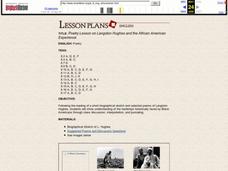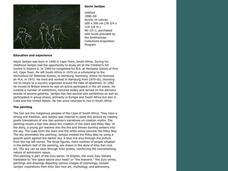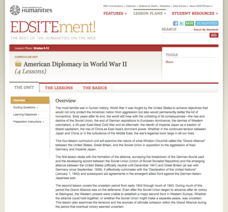Curated OER
Romare Bearden's The Dove - A Meeting of Vision and Sound
Students explore African american culture of the late 1950's and 60's through various primary sources including literature, music, art and others. They then prepare and conduct a mock interview and present with the class.
Curated OER
ANTICIPATORY SET
Learners are be able to analyze primary sources (photographs and speeches) and write a definition of American Democracy. They are shown a photograph of Martin Luther King Jr. by Ben Fernandez, students are asked what is happening in the...
Curated OER
Jazz Talk
Middle schoolers analyze the origins of jazz music by examining work songs, spirituals, blues, and gospel songs as well as works of poetry from African American artists. They create their own poems from either the narrative, dramatic,...
Atlanta History Center
Civil Disobedience and the Atlanta Student Movement
What tactics are used in civil disobedience? Learners study the conditions in Alabama that led to the establishment of the Atlanta Student Movement, as well as consider the nature and effectiveness of civil disobedience.
Smithsonian Institution
Native Resistance: Native Resistance Then and Now
Native Americans lost so much—and gained so little in return. Scholars explore Native Americans' resistance to the United States government. The lesson plan uses primary sources to explore the different forms of protest and gives a voice...
National Park Service
Lesson 5: Coded Spirituals, Metaphor in African Spirituals
If a picture is worth a thousand words, song lyrics also can communicate many meanings. Using the lyrics of spirituals, young historians analyze them for coded messages about freedom. Resources include a chart to help individuals track...
Simon & Schuster
Classroom Activities for Narrative of the Life of Frederick Douglass, an American Slave
The Narrative of the Life of Frederick Douglass is the focus of three activities designed for readers of the autobiography. First, class members deconstruct the title to understand Douglass's purpose in writing. Next, scholars examine...
EngageNY
Reading to Determine Important Relationships between People and Events: The Importance of the 1936 Olympics for African Americans (Promises to Keep, Pages 16–19)
Scholars look at cause-and-effect relationships while doing a close read of the 1936 Olympics on pages 16-19 of Promises to Keep. They complete a cause-and-effect note catcher and add their ideas to an anchor chart. Readers then work...
EngageNY
Determining Author’s Opinions, Reasons, and Evidence: Signs of Hope and Progress for African Americans in the 1920s (Promises to Keep, Pages 14–15)
Caption this. Readers look at the text features in Promises to Keep and pay special attention to the photographs and captions before adding to the Features of Informational Text anchor chart. Learners then answer questions about life in...
American Institute of Physics
The Tuskegee Weathermen: African-American Meteorologists during World War II
Chances are good that young scholars have heard of the Tuskegee Airmen but few would predict that these pilots had their own support in the form of the Tuskegee Weathermen. These Black meteorologists were recruited and trained to provide...
Curated OER
African Americans and the Democratic Party
Students identify factors that caused African Americans to shift party loyalty from the Republican Party to the Democratic Party. They review ways in which African Americans benefited from New Deal programs. Students analyze primary...
Curated OER
POETRY LESSON ON LANGSTON HUGHES AND THE AFRICAN AMERICAN EXPERIENCE
Eighth graders read the short biographical sketch and selected poems of Langston Hughes, 8th graders examine the hardships historically faced by Black Americans through class discussion, interpretation, and journaling.
Curated OER
Let Your Motto Be Resistance: African American Portraits
Learners compare and contrast historical and contemporary photographs of important figures in African American history. In this photography analysis lesson, students learn key photography vocabulary and use a Venn Diagram to explore...
Curated OER
Transportation and African-American Migration
Students examine an aspect of either railroad or marine transportation (for example: routes, Pullman porters' work routines, or African-American merchant sailors) and evaluate their impact on migration in the United States.
National Endowment for the Humanities
American Diplocmacy in World War II
The end of World War II saw the world deeply changed over the last few years. Four thorough lessons explore post-war Europe, America, and Asia through reading assignments and discussion questions about the Grand Alliance and the signing...
C3 Teachers
Uncle Tom’s Cabin: Can Words Lead to War?
"Words, words, words." Despite Hamlet's opinion, words can be significant. In this inquiry lesson, middle schoolers learn how the words in Harriet Beecher Stowe's Uncle Tom's Cabin, in the view of many, lead to the American Civil War. To...
Curated OER
Take a Memo - Primary Documents: African American Soldiers on the Homefront
Pupils examine the discrimination experienced by black servicemen during World War II. They read and analyze an official memo written in 1943, complete worksheet questions, and participate in a class discussion.
Curated OER
From Remus to Rap: A History in Theory and Practice of the African-American Storytelling Tradition
Students examine the specific form and function of tall tales and toasts.
They discover the importance of performance in the telling of a story and the importance of rhythm in the telling of toasts. They create stories of their own, in...
Curated OER
The Role of African American soldiers in World War II
Students design and create a poster, advertising for recruitment of African American volunteers for the Tuskegee Airmen. Students Create a historical newspaper front page, from 1996, which details the awarding of the Medal of Honor to...
Curated OER
Changes in African-American Expression from the Harlem Renaissance to the Present
Students examine and analyze struggle for racial and gender equality, influences on African-American culture during the 1920s, and economic boom and social transformation of post-World War II United States.
Curated OER
African Americans during the Great Depression
Students interpret patterns of behavior reflecting values and attitudes that contribute or pose obstacles to cross-cultural exploration. They explain and apply ideas, theories and modes of inquiry drawn from anthropology and sociology in...
Curated OER
The AME Church in U.S. History
Ninth graders explore the history of the African Methodist Church in the United States. In this African American history lesson, 9th graders discover why the church was founded and research its history and noteworthy members. Students...
Curated OER
Benne Cakes and Other Holiday Recipes
Benne Cakes, a West African treat packed with sesame seeds for luck, are a featured part of the celebration of Kwanzaa. Young chefs try their hand at crafting these goodies that are sure to enrich your holiday feast.
Library of Congress
The Harlem Renaissance
The Harlem Renaissance brought forth many American art forms including jazz, and the writings of Zora Neale Hurston and Langston Hughes. Using a carefully curated set of documents from the Library of Congress, pupils see the cultural...
Other popular searches
- Famous African Americans
- Free African Americans
- Rap and African Americans
- Aids and African Americans
- Displaced African Americans
- Famous African Americans
- African Americans in History
- Free African Americans
- African Americans Today
- Wwii African Americans
- African Americans and Wwi
- African Americans in History

























